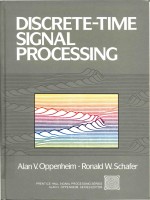图书介绍
Discrete-time signal processingPDF|Epub|txt|kindle电子书版本网盘下载

- Alan V. Oppenheim ; Ronald W. Schafer 著
- 出版社: Prentice Hall
- ISBN:
- 出版时间:1989
- 标注页数:880页
- 文件大小:105MB
- 文件页数:899页
- 主题词:
PDF下载
下载说明
Discrete-time signal processingPDF格式电子书版下载
下载的文件为RAR压缩包。需要使用解压软件进行解压得到PDF格式图书。建议使用BT下载工具Free Download Manager进行下载,简称FDM(免费,没有广告,支持多平台)。本站资源全部打包为BT种子。所以需要使用专业的BT下载软件进行下载。如BitComet qBittorrent uTorrent等BT下载工具。迅雷目前由于本站不是热门资源。不推荐使用!后期资源热门了。安装了迅雷也可以迅雷进行下载!
(文件页数 要大于 标注页数,上中下等多册电子书除外)
注意:本站所有压缩包均有解压码: 点击下载压缩包解压工具
图书目录
1 Introduction1
2 Discrete-Time Signals and Systems8
2.0 Introduction8
2.1 Discrete-Time Signals:Sequences9
2.2 Discrete-Time Systems17
2.3 Linear Time-Invariant Systems21
2.4 Properties of Linear Time-Invariant Systems27
2.5 Linear Constant-Coefficient Difference Equations33
2.6 Frequency-Domain Representation of Discrete-Time Signals and Systems39
2.7 Representation of Sequences by Fourier Transforms45
2.8 Symmetry Properties of the Fourier Transform52
2.9 Fourier Transform Theorems56
2.10 Discrete-Time Random Signals63
2.11 Summary67
Problems68
3 Sampling of Continuous-Time Signals80
3.0 Introduction80
3.1 Periodic Sampling80
3.2 Frequency-Domain Representation of Sampling82
3.3 Reconstruction of a Bandlimited Signal from Its Samples87
3.4 Discrete-Time Processing of Continuous-Time Signals91
3.5 Continuous-Time Processing of Discrete-Time Signals99
3.6 Changing the Sampling Rate Using Discrete-Time Processing101
3.7 Practical Considerations112
3.8 Summary130
Problems131
4 The z-Transform149
4.0 Introduction149
4.1 The z-Transform149
4.2 Properties of the Region of Convergence for the z-Transform160
4.3 The Inverse z-Transform165
4.4 z-Transform Properties172
4.5 The Inverse z-Transform Using Contour Integration181
4.6 The Complex Convolution Theorem184
4.7 Parseval’s Relation186
4.8 The Unilateral z-Transform188
4.9 Summary191
Problems192
5 Transform Analysis of Linear Time-Invariant Systems202
5.0 Introduction202
5.1 The Frequency Response of LTI Systems203
5.2 System Functions for Systems Characterized by Linear Constant-Coefficient Difference Equations206
5.3 Frequency Response for Rational System Functions213
5.4 Relationship Between Magnitude and Phase230
5.5 Allpass Systems234
5.6 Minimum-Phase Systems240
5.7 Linear Systems with Generalized Linear Phase250
5.8 Summary270
Problems270
6 Structures for Discrete-Time Systems290
6.0 Introduction290
6.1 Block Diagram Representation of Linear Constant-Coefficient Difference Equations291
6.2 Signal Flow Graph Representation of Linear Constant-Coefficient Difference Equations297
6.3 Basic Structures for IIR Systems300
6.4 Transposed Forms309
6.5 Basic Network Structures for FIR Systems313
6.6 Lattice Structures317
6.7 Overview of Finite-Precision Numerical Effects328
6.8 The Effects of Coefficient Quantization335
6.9 Effects of Roundoff Noise in Digital Filters351
6.10 Zero-Input Limit Cycles in Fixed-Point Realizations of IIR Digital Filters373
6.11 Summary378
Problems379
7 Filter Design Techniques403
7.0 Introduction403
7.1 Design of Discrete-Time IIR Filters from Continuous-Time Filters406
7.2 Frequency Transformations of Lowpass IIR Filters430
7.3 Computer-Aided Design of Discrete-Time IIR Filters438
7.4 Design of FIR Filters by Windowing444
7.5 Examples of FIR Filter Design by the Kaiser Window Method458
7.6 Optimum Approximations of FIR Filters464
7.7 Examples of FIR Equiripple Approximation481
7.8 Comments on IIR and FIR Digital Filters488
7.9 Summary489
Problems490
8 The Discrete Fourier Transform514
8.0 Introduction514
8.1 Representation of Periodic Sequences:The Discrete Fourier Series515
8.2 Properties of the Discrete Fourier Series520
8.3 Summary of Properties of the DFS Representation of Periodic Sequences525
8.4 The Fourier Transform of Periodic Signals526
8.5 Sampling the Fourier Transform527
8.6 Fourier Representation of Finite-Duration Sequences:The Discrete Fourier Transform530
8.7 Properties of the Discrete Fourier Transform535
8.8 Summary of Properties of the Discrete Fourier Transform547
8.9 Linear Convolution Using the Discrete Fourier Transform548
8.10 Summary560
Problems561
9 Computation of the Discrete Fourier Transform581
9.0 Introduction581
9.1 Efficient Computation of the Discrete Fourier Transform582
9.2 The Goertzel Algorithm585
9.3 Decimation-in-Time FFT Algorithms587
9.4 Decimation-in-Frequency FFT Algorithms599
9.5 Implementation of FFT Algorithms605
9.6 FFT Algorithms for Composite N610
9.7 Implementation of the DFT Using Convolution622
9.8 Effects of Finite Register Length in Discrete Fourier Transform Computations628
9.9 Summary641
Problems642
10 Discrete Hilbert Transforms662
10.0 Introduction662
10.1 Real and Imaginary Part Sufficiency of the Fourier Transform for Causal Sequences664
10.2 Sufficiency Theorems for Finite-Length Sequences670
10.3 Relationships Between Magnitude and Phase674
10.4 Hilbert Transform Relations for Complex Sequences676
10.5 Summary689
Problems689
11 Fourier Analysis of Signals Using the Discrete Fourier Transform695
11.0 Introduction695
11.1 Fourier Analysis of Signals Using the DFT696
11.2 DFT Analysis of Sinusoidal Signals699
11.3 The Time-Dependent Fourier Transform713
11.4 Block Convolution Using the Time-Dependent Fourier Transform721
11.5 Fourier Analysis of Nonstationary Signals723
11.6 Fourier Analysis of Stationary Random Signals:The Periodogram730
11.7 Spectrum Analysis of Random Signals Using Estimates of the Autocorrelation Sequence742
11.8 Summary755
Problems756
12 Cepstrum Analysis and Homomorphic Deconvolution768
12.0 Introduction768
12.1 Definition of the Complex Cepstrum769
12.2 Homomorphic Deconvolution771
12.3 Properties of the Complex Logarithm775
12.4 Alternative Expressions for the Complex Cepstrum778
12.5 The Complex Cepstrum of Exponential Sequences779
12.6 Minimum-Phase and Maximum-Phase Sequences781
12.7 Realizations of the Characteristic System D*[·]787
12.8 Examples of Homomorphic Filtering797
12.9 Applications to Speech Processing815
12.10 Summary825
Problems826
Appendix A Random Signals835
A.1 Discrete-Time Random Processes835
A.2 Averages837
A.3 Properties of Correlation and Covariance Sequences841
A.4 Transform Representations of Random Signals843
Appendix B Continuous-Time Filters845
B.1 Butterworth Lowpass Filters845
B.2 Chebyshev Filters847
B.3 Elliptic Filters849
Bibliography851
Index869